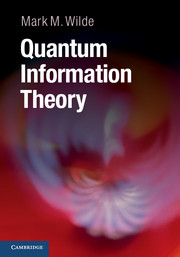Book contents
- Frontmatter
- Contents
- How To Use This Book
- Acknowledgments
- Part I Introduction
- Part II The Quantum Theory
- Part III Unit Quantum Protocols
- Part IV Tools of Quantum Shannon Theory
- 9 Distance Measures
- 10 Classical Information and Entropy
- 11 Quantum Information and Entropy
- 12 The Information of Quantum Channels
- 13 Classical Typicality
- 14 Quantum Typicality
- 15 The Packing Lemma
- 16 The Covering Lemma
- Part V Noiseless Quantum Shannon Theory
- Part VI Noisy Quantum Shannon Theory
- Appendix A Miscellaneous Mathematics
- Appendix B Monotonicity of Quantum Relative Entropy
- References
- Index
11 - Quantum Information and Entropy
from Part IV - Tools of Quantum Shannon Theory
Published online by Cambridge University Press: 05 May 2013
- Frontmatter
- Contents
- How To Use This Book
- Acknowledgments
- Part I Introduction
- Part II The Quantum Theory
- Part III Unit Quantum Protocols
- Part IV Tools of Quantum Shannon Theory
- 9 Distance Measures
- 10 Classical Information and Entropy
- 11 Quantum Information and Entropy
- 12 The Information of Quantum Channels
- 13 Classical Typicality
- 14 Quantum Typicality
- 15 The Packing Lemma
- 16 The Covering Lemma
- Part V Noiseless Quantum Shannon Theory
- Part VI Noisy Quantum Shannon Theory
- Appendix A Miscellaneous Mathematics
- Appendix B Monotonicity of Quantum Relative Entropy
- References
- Index
Summary
In this chapter, we discuss several information measures that are important for quantifying the amount of information and correlations that are present in quantum systems. The first fundamental measure that we introduce is the von Neumman entropy. It is the quantum analog of the Shannon entropy, but it captures both classical and quantum uncertainty in a quantum state. The von Neumann entropy gives meaning to a notion of the information qubit. This notion is different from that of the physical qubit, which is the description of a quantum state in an electron or a photon. The information qubit is the fundamental quantum informational unit of measure, determining how much quantum information is in a quantum system.
The beginning definitions here are analogous to the classical definitions of entropy, but we soon discover a radical departure from the intuitive classical notions from the previous chapter: the conditional quantum entropy can be negative for certain quantum states. In the classical world, this negativity simply does not occur, but it takes a special meaning in quantum information theory. Pure quantum states that are entangled have stronger-than-classical spatial correlations and are examples of states that have negative conditional entropy. The negative of the conditional quantum entropy is so important in quantum information theory that we even have a special name for it: the coherent information. We discover that the coherent information obeys a quantum data-processing inequality, placing it on a firm footing as a particular informational measure of quantum correlations.
- Type
- Chapter
- Information
- Quantum Information Theory , pp. 252 - 291Publisher: Cambridge University PressPrint publication year: 2013

